Japan is a country with a fascinating history, some incredible landscapes, and an incredible cuisine. If you want to really experience the Japanese culture, you have to spend more than just a few days in this country.
I recommend spending 3 weeks in Japan. You’ll be amazed by all the things this country has to offer. What I really loved about Japan is that it has something to offer to everyone.

If you’re passionate about culture, there are thousands of temples and traditions waiting to be explored. If you want a fun holiday, the night-life in Japan is simply fascinating. If you’re a nature lover, don’t worry! Japan is full of jaw-dropping sights and natural wonders. Waterfalls, volcanoes, and mountains – you name it!
In this post, I’ll share with you which are the places you have to visit if you’re planning a Japan 3 week itinerary. Eat something, grab a coffee, and be patient. This in-depth guide might be long but it has tons of useful information in it!
But first, let’s talk about some important things you need to know before planning a 3-week trip to Japan.
1. 3 weeks in Japan – MAP
Places included on this itinerary:
- Nagasaki -> Hiroshima -> Osaka -> Nara -> Kyoto -> Mount Fuji -> Tokyo -> Nagano -> Matsumoto -> Tokyo
2. Budget
Let’s face it – when planning a trip, the budget is very important. You need to know what to expect or else you’ll end up breaking the bank.
Japan is an EXPENSIVE country! (It’s bold on purpose)
Japan is one of the most expensive countries in Asia and there’s no way around that. Let’s put it this way – traveling on a budget in Japan is more expensive than luxury travel in Indonesia.
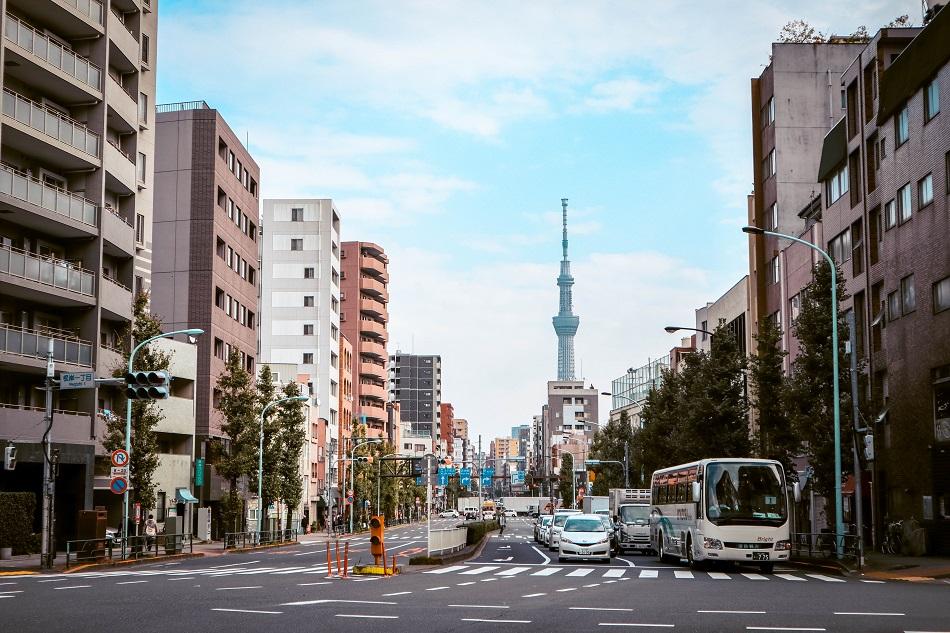
I’m not telling you this to discourage you. I just want you to set the right expectations.
Now that we’ve established that spending 21 days in Japan won’t be cheap, let’s see how much money you really need. In the section below I shared the average costs for a 3-week holiday in Japan for 3 different budget ranges – budget, mid budget, and luxury.
-> Are you planning to backpack in Japan? Read this guide!
Good to know: the prices below are per person. Also, keep in mind that the prices are different from city to city. I tried to make an average for all the cities included in this itinerary.
Accommodation in Japan
If you’re on a very tight budget, you’ll need to choose a bed in a dorm. You can find a bed in a hostel dorm room for about $20. A private room in a hostel will set you back $60.
If you have a little extra money, you can find a nice room with a private bathroom, in a good neighborhood for about $90-$120. One thing you have to keep in mind when traveling to Japan is the fact that hotel rooms & guesthouses rooms are usually very small. However, the Japanese somehow manage to include all the amenities you need in such small spaces. Pretty cool!
P.S. We had an incredible one-bedroom apartment in Osaka which was pretty small but had everything we needed, including a kitchen and a washing machine.
Now, if you’re one of those lucky ones who have lots of money, you won’t have to worry about the lack of space. Luxury hotels in Japan are pretty darn incredible and there are plenty of options to choose from. For a room in a luxury hotel, expect to pay between $190-$600.

All in all, if you’re willing to sleep in a dorm, the accommodation in Japan isn’t that expensive. However, you’ll have to pay quite a lot for privacy and space.
In conclusion, if you’re on a budget, the accommodation for 3 weeks in Japan will cost $441. For those in the “mid budget” range, the accommodation will cost $1890 – $2520. For those lucky ones in the luxury category, 21 nights in Japan will cost at least $3990.
Good to know: I traveled full time around Asia for one and a half years and I only used one hotel booking website – Booking.com . I love that they have plenty of options and you can choose your desired price range. I totally recommend it!
No time to read now? Pin it for later!
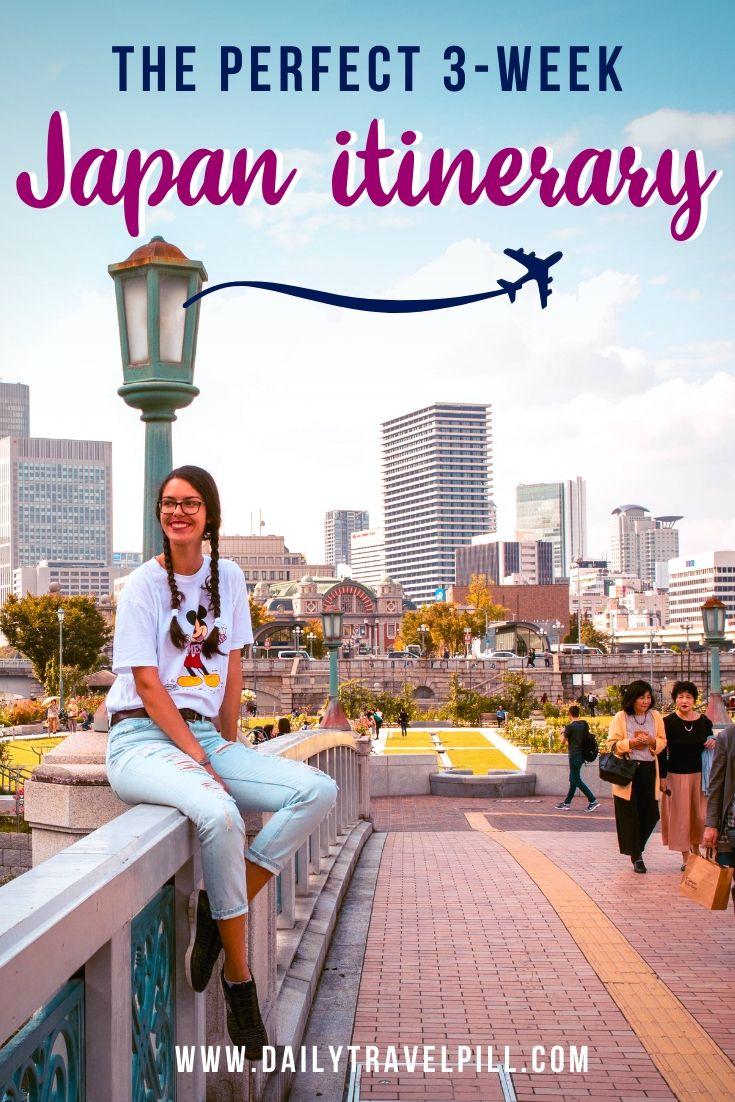


Transport in Japan
The cost of transport when planning a Japan 3-week itinerary is another expense we can’t ignore. The most important advice I can give you is – BUY A JR PASS!
Trains in Japan are super-expensive but with a JR Pass you’ll save hundreds of dollars. I recommend buying a 3-week pass which will cover all your train journeys (it costs $564).
Apart from the JR Pass, you’ll need to put aside some money for subways & buses. I think around $120 should be enough. This means that transportation wise for a 3-week holiday in Japan you’ll need about $684.
Food in Japan

While in Japan, you have to try ramen soup and sushi. The good news is that as long as you’re not going to fancy restaurants, a meal in Japan won’t be very expensive. For a ramen soup at a mid-range restaurant, expect to pay somewhere around $10-$15.
If you’re on a strict budget, try the street food! Snacks like takoyaki cost only $5. Another option is to try the snacks and sandwiches from 7-Eleven!
If you want to dine at fancy restaurants in Japan, a meal can cost you as much as $200.
Activities & entrance fees in Japan
The amount of money you’ll spend on activities and entrance fees for a 3 week Japan holiday is totally up to you. It really depends on how many museums, temples & tourist attractions you want to visit in each city.
I recommend setting aside at least $250 for activities.
Grand total
Now, the moment of truth. Are you curious to see which is the final budget for three weeks in Japan?
- Budget – $1900 per person – $90 per day
- Mid Budget – $3660 – $4300 per person – $175-$200 per day
- Luxury – $8100 per person – $385 per day
Keep in mind that if you’re traveling as a couple, the costs will be a little bit lower. You’ll save some money on accommodation because you can share costs.
Also, I haven’t included additional costs (toiletries, souvenirs, and other expenses) & plane tickets to Japan in this budget.
In conclusion, the cost of a 3-week itinerary in Japan doesn’t have to break the bank. It’s definitely not cheap but if you’re determined to make it work, you can do it!
3. Things you need to know before visiting Japan
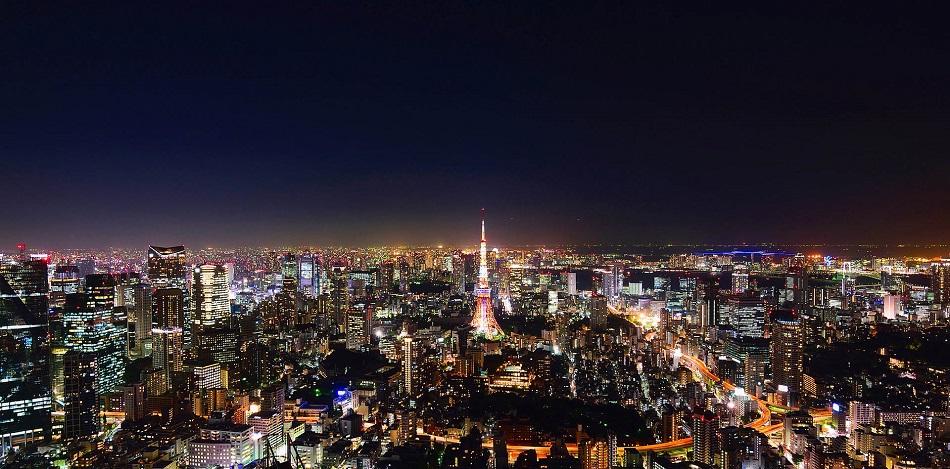
To make your trip easier and more enjoyable, there are some things that you should keep in mind when visiting Japan. It’s important to be mindful to local traditions but also to prepare yourself for a few things.
- Tattoos in Japan are considered taboo – I love tattoos, I have 2 myself. They are a way to express yourself but in Japan people associate tattoos with criminals or more specifically, the members of the Yakuza gang. If you have tattoos, you can be denied access to onsens, pools or saunas.
- You don’t have to tip in Japan – while in western countries tipping is extremely appreciated, in Japan you don’t have to do it. Most probably, if you tip someone, that person will run after you trying to give your money back. The truth is that the Japanese are happy with their salaries.
- The Japanese have a thing for fake food – you’ll see it all over the country – fake food displayed at the restaurant’s entrances. This is how a menu looks in Japan. You basically have to look at the fake dishes and choose what you want to eat. Most of the time, restaurants provide paper menus too.
- Big cities are extremely crowded – even though cities like Tokyo and Osaka are very crowded, everything works on point in Japan, including the transport system. Keep in mind that when riding escalators, you have to queue on the right side except for Osaka where you have to queue on the left side of the escalator.
- Using a toilet in Japan is not as easy as it seems – knowing how to use a toilet in Japan requires a university degree. It’s not as simple as it seems. The toilets have tens of functions and even something simple as flushing the toilet can become a challenge.
4. Japan itinerary – 3 weeks
This Japan itinerary for 21 days is perfect if you want to discover everything that Japan has to offer. From history to culture and cuisine, everything is included here. This itinerary is a mix of big and small cities, perfect for those who want to experience a bit of everything.
Important! In the version below, the itinerary starts with Nagasaki and ends with Tokyo but you can start the other way around.
Make sure to get a JR Pass which will cover most of the train costs for this itinerary. You’ll save a lot of money!
Day 1-2 in Nagasaki – 2 days, 2 nights
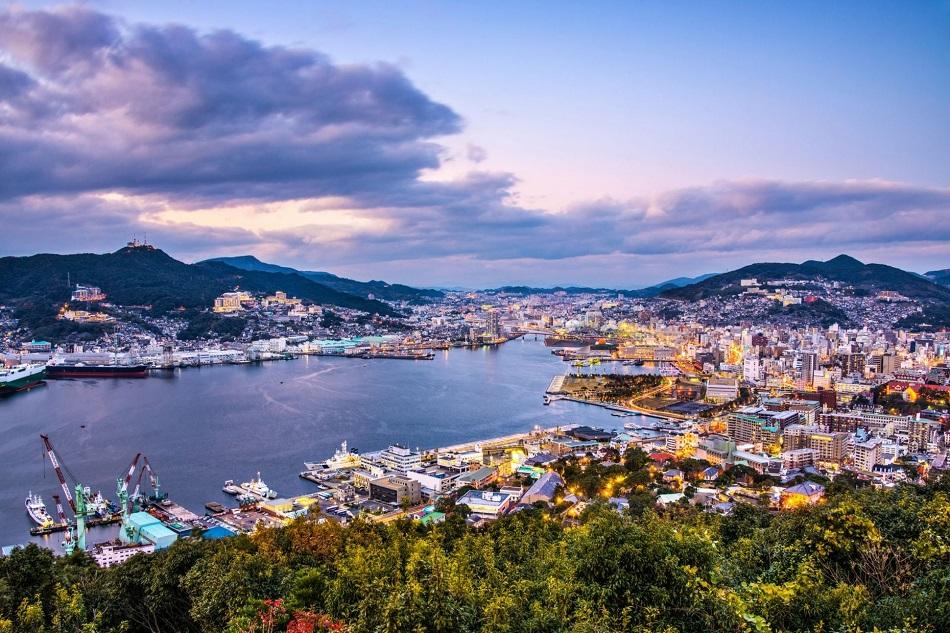
Our three week Japan itinerary starts in the south of the country, in Nagasaki on the island of Kyushu. During World War II, Nagasaki became the last city in the world to ever experience a nuclear attack.
With a strong Portuguese and Dutch architectural influence, Nagasaki has a different vibe comparing to other Japanese cities. It’s the perfect place to start your Japanese adventure and discover some incredible sights.
On day one you’ll probably land on the Nagasaki Airport. Although the airport isn’t big, it has connections with Seoul, Shanghai, and Hong Kong. Also, there are many domestic flights from cities like Tokyo and Osaka.
For day two, I have some awesome suggestions for activities in Nagasaki. I will list them down below.
- Visit the Nagasaki Atomic Bomb Museum – if you want to learn more about World War II, this is the place for you! Find out the story and the events that led to the atomic bombing at Nagasaki which killed and injured 150,000 people.
- Visit the Peace Park – situated next to the Atomic Bomb Museum, the main attraction at Peace Park is the statue created by Seibo Kitamura. The statue’s right hand points towards the sky, symbolizing the threat of atomic bombs while the left hand extended parallel with the horizon symbolizes peace.
- Explore Dejima – this former artificial island in the bay of Nagasaki was built in 1634 to separate Portuguese traders from the Japanese society. Today a number of structures at Dejima survived the passing of time and they can be visited by curious tourists.
- Visit the Glover Garden – built for Thomas Blake Glover, a Scottish merchant who had an important contribution to Japan’s modernization, Glover Garden is a great place for a walk. Admire the Koi pond and the beautiful Glover Residence.
- Explore Shinchi Chinatown – dating from the 15th century, Shinchi Chinatown is the oldest Chinatown in all Japan. If you want to try some delicious Chinese street food or maybe buy some Chinese items, a walk through Chinatown in Nagasaki should be on your itinerary.
- Visit the Suwa Shrine – located in the northern part of the city, the Suwa Shrine in Nagasaki overlooks the city. To get there, you’ll have to climb 227 stone steps but the views over the city are well worth it. This shrine is well known for its quirky sculptures so make sure to admire them.
- Admire the view from Mt. Inasa – are you ready for the best view over Nagasaki? I recommend climbing Mt. Inasa at the end of the day, at sunset. You can either reach the top by ropeway, bus or car. Take your time and admire the city from above!
There are plenty of activities to do and tourist attractions to visit in Nagasaki but on day 3, it’s time to move to our next destination – Hiroshima.
To get to Hiroshima from Nagasaki, you will have to take the train and change at Hakata. The good news is that the train ride is fully covered by the JR Pass. The train ride will take about 3 hours and a half. I recommend getting up early to get to Hiroshima somewhere around lunchtime. This way, you’ll have an extra half day to explore Hiroshima.
Where to stay in Nagasaki
- Budget – Nagasaki Royal Chester Hotel – excellent value for money, good location, clean & spacious rooms
- Mid Budget – Hotel New Nagasaki – great location, excellent staff, modern rooms, great amenities
- Luxury – Garden Terrace Nagasaki Resort – incredible infinity pool overlooking the city, great restaurant, spacious & modern rooms, best hotel in the city
Day 3-4 in Hiroshima – 2 days, 2 nights

This ultimate 3-week Japan itinerary wouldn’t be complete without a stop to Hiroshima. While Nagasaki was the last city ever hit by a nuclear bomb, Hiroshima was the first one. The Hiroshima bombing during World War II killed somewhere between 90,000-160,000 people.
Even though the city has a dark past, after the war the locals rebuilt Hiroshima and made it a thriving and flourishing city. Nowadays, Hiroshima is a hot tourist attraction full of museums, parks, temples, and with great gastronomy.
Good to know – To make your life easier and save some money, I recommend getting a Hiroshima Tourist Pass. This pass will grant you unlimited rides on buses, streetcars, and Miyajima ferries.
If you follow my advice and leave Nagasaki early in the morning, you’ll have one and a half days to explore Hiroshima (on the third day we’ll head to our next destination – Osaka). Below is a list of incredible tourist attractions you can visit in Hiroshima.
- Visit the Atomic Bomb Dome – this is the most important tourist attraction in Hiroshima. The story of this place is truly fascinating. Although the dome was located underneath the explosion, it somehow survived the bombing and the building still stands today.
- Visit the Peace Memorial Museum – if you’d like to learn more about the detailed chronology of the events leading to the bombing, you have to visit this museum. I have to warn you, the Peace Memorial Museum is not for the faint-hearted.
- Go shopping at Hondori Shotengai – this covered shopping street is full of clothing & accessories stores. It’s a great area to shop for souvenirs and find some cheap gems.
- Explore the Miyajima Island – take a half-day private cruise around this beautiful island, also known as the “Shrine Island”. On this island, you can find the famous floating torii gate of Itsukushima Shrine and hundreds of deer you can play with. If you’re looking for a unique experience on Miyajima Island, attend a tea ceremony!
- Admire the Hiroshima Castle – even though the original castle was destroyed during World War II, it has been rebuilt in 1958. The replica of the original is nowadays a museum and the castle is an amazing representation of the Japanese architecture.
- Book a Bay Dinner Cruise – spend a romantic evening along the Hiroshima Bay while admiring the stunning views. Enjoy your full-course dinner aboard of a cruise ship. This is definitely a once-in-a-lifetime experience and you can enjoy it with your partner or loved ones.
- Admire the city from Hijiyama Park – walk to the top of the park and admire the amazing view over Hiroshima. If you happen to be there in spring, you’ll be welcomed with some incredible cherry blossoms.
- Visit Mitaki-dera Temple – also known as the “Three Waterfalls Temple”, Mitaki-dera has a beautiful two storey pagoda. This place is famous for its beautiful cherry blossoms in spring and colorful leaves in autumn.
Hiroshima has a lot to offer in terms of culture, history and tourist attractions in general. After exploring this city, it’s time to continue our 3 weeks Japan route and head to our next destination – Osaka.
To get from Hiroshima to Osaka, use your JR Pass and take the Shinkansen bullet train. Choose the Hikari or Sakura Shinkansen and you’ll get to Osaka in a little over one hour and a half.
Where to stay in Hiroshima
- Budget – Kamon Hotel Setuo – excellent location, clean rooms, super-friendly staff
- Mid Budget – Hotel Granvia Hiroshima – great view over the city, excellent location, modern & spacious rooms
- Luxury – Sheraton Grand Hiroshima Hotel – incredible views, luxury feel, spacious rooms, great amenities
Day 5-7 in Osaka – 3 days, 4 nights

One of the top things to see in Japan in 3 weeks is Osaka. This vibrant city is the second largest city in Japan and a cultural melting pot. Osaka is the perfect combination between history and modernity and this is exactly what made me fall in love with it.
This city has a little bit of everything – temples, modern buildings, a castle, an amazing night-life, and delicious cuisine. Are you ready to explore Osaka? Below you’ll find the main tourist attractions in the city.
If you get to Osaka in the morning, I recommend spending that half-day and the next one exploring the city. On the second full-day in Osaka you can visit Universal Studios Japan. On your last full day in Osaka, I recommend taking a day trip to Nara (more about this in the next section). Use the last night in Osaka to catch some sleep because the next day we’ll be heading to our next destination – Kyoto.
Good to know – if you want to save some money, get the Osaka Amazing Pass. With it, you’ll have free access to Osaka’s main tourist attractions and on top of that, you’ll also get unlimited use of the subway and bus system. For prices, click here.
- Admire the Osaka Castle – learn more about Osaka’s history at the Osaka Castle. For one of the best views over the city, climb the stairs or take the elevator to the top of the castle.
- Have fun at Universal Studios Japan – what would you say about spending an entire day at one of the best amusement parks in the world? Book your tickets for Universal Studios Japan and enjoy some of the coolest roller-coasters! The day spent at USJ was one of the highlights of my trip to Japan.
- Explore Shitenno-Ji Temple – built in 593, Shitenno-Ji is one of the oldest temples in Japan. Although the temple was destroyed a few times in the past, it has been rebuilt to reflect the original architecture.
- Visit the quirky Shinsekai – this quirky neighborhood was built to resemble both New York and Paris. Even though after the war this was one of the poorest areas in Osaka, nowadays Shinsekai is a major tourist attraction. People come here for a wide range of restaurants, shops, and the famous Tsutenkaku Tower.
- Admire the city from the top of Abeno Harukas – you can admire Osaka from the top of the tallest skyscraper in Japan at Abeno Harukas. You can enjoy the views from the 16th floor for free but getting to the top of the building (60th floor) requires a ticket.
- Step back in time at Hozenji Yokocho – this narrow street full of restaurants and bars is the perfect place for a short walk. What makes it unique is its architecture.
- Go to the Osaka Pokemon Center – are you a Pokemon fan? If yes, make sure to visit the Osaka Pokemon Center. Here you’ll find stuffed Pokemons and a wide range of Pokemon merchandise.
- Enjoy the night-life at Dotonbori – you can’t visit Osaka without stopping by Dotonbori during the night. Thousands of neon lights and arcade game centers are waiting for you. Also, there are hundreds of shops here selling pretty much anything. Have fun!
Osaka is not as expensive as other cities in Japan. Visiting it on a budget is totally do-able! There are many tourist attractions you can visit in this city and I’m sure that you’ll have a lot of fun discovering them all!
For your last day in Osaka, I recommend a day trip to Nara where deer roam free around the city. More about this in the section below. After our short stop in Nara, it’s time to take the train and head to our next destination – Kyoto!
Where to stay in Osaka
- Budget – Rakuten Stay – good location, very clean rooms, beautiful design, excellent staff
- Mid Budget – Hare Shin – traditional yet modern design, spacious rooms, good location, very clean
- Luxury – Marriott Hotel – incredible views, excellent location, fitness center, clean & spacious rooms, excellent staff
Day 8 in Nara – 1 day (day trip from Osaka)
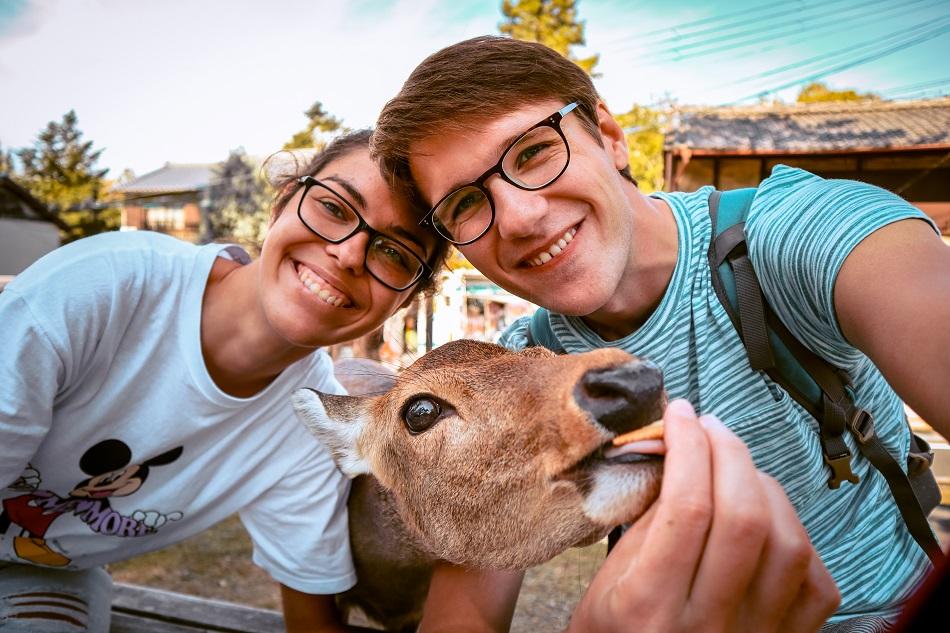
Are you wondering what else to visit in Japan in 3 weeks? I have a surprise for you – our next stop is a unique city where deer roam free on the streets and on top of that they’re super-friendly. How awesome is that?
Nara is by far my favorite city in Japan. You’ll see hundreds of deer on the streets, in parks, at temples and pretty much anywhere. Make sure to buy some deer crackers and they’ll be your friends forever!
To get to Nara, take the train from Osaka-Namba Station to Kintetsu Nara Station. The train ride will take about 40 minutes and then you’ll have to walk for another 20 minutes to get to Nara Park.
Apart from all the cute deer, there are some other interesting things to do in Nara. You can visit some incredible Japanese gardens and explore beautiful temples. To read more about the places you can visit in Nara in one day, click here.
Day 9-10 in Kyoto – 2 days, 2 nights

One of the things to see in Japan in 3 weeks is Kyoto. With 1600 Buddhist temples and 400 Shinto shrines, Kyoto is the perfect place to find out more about the Japanese culture. Even though it’s a big city, it somehow has the vibe of a village and I loved that about it.
Make sure to leave Osaka early in the morning and you’ll have one and a half days to explore the beautiful Kyoto. That’s plenty of time to visit the most important tourist attractions around the city. Let’s see which are the places you have to visit when in Kyoto.
Good to know: I recommend getting a Kyoto sightseeing pass which includes free entrance fee to all the major tourist attractions in the city.
- Get lost in Arashiyama Bamboo Forest – probably one of the most visited and photographed locations in Kyoto is the Bamboo Forest. The tall bamboo pillars create an incredible view and the good news is that you can walk inside the forest and admire them.
- Explore Fushimi Inari Shrine – with more than 1,000 red torii gates creating a long tunnel, the Fushimi Inari Shrine is a unique sight. In the 17th century, people used to donate a torii gate to make their wish come true. That’s the reason why today there are so many torii gates at Fushimi Inari Shrine.
- Taste the food at Nishiki Market – this is one of the oldest and most popular markets in Japan. At Nishiki Market you can find more than 100 stalls selling fresh Japanese delicacies. Don’t hesitate to try the seafood! Simply delicious!
- Buy souvenirs at Teramachi Street – right near Nishiki Market is Teramachi Street. If you’re looking for some souvenirs, this is the place to go! Apart from souvenirs here you can find traditional Japanese items such as kimonos but also modern clothes and accessories.
- Admire the Yasaka Shrine – a popular place for photo-shoots, Yasaka Shrine is one of the most important shrines in Kyoto. If you want to take some photos, you’ll find some shops at the entrance, renting kimonos. Otherwise, take your time to admire the shrine’s architecture and take a walk around Maruyama Park.
- Admire the view from Kyoto Tower – enjoy a unique view over Kyoto from the 100 m tall Kyoto Tower observation deck. I recommend going at sunset when the whole city lights up. To book your tickets, click here.
- Find a geisha in Gion – you can’t visit Kyoto without stopping at Gion neighborhood. If you want to see a geisha, make sure to be in Gion at 5.45 pm sharp. That’s when the geishas leave their homes to go to their appointments.
There’s plenty to do in Kyoto in one a half days but it’s time to head to our next destination – Mt. Fuji. There are many places from where you can admire the most iconic volcano in the world but the best location is Kawaguchiko and that’s where we’re heading.
To get to Kawaguchiko from Kyoto you’ll have to take the Shinkansen train from Kyoto to Mishima. From Mishima, take an express bus to Kawaguchiko. It’s important to mention that only the train is covered by the JR Pass. For the bus, you’ll have to pay by yourself.
Where to stay in Kyoto
- Luxury – Hotel Granvia – beautiful pool, incredible views, excellent location, comfortable & luxurious rooms, breakfast included
- Mid Budget – Solaria Hotel Premier – excellent location, incredible architecture & views, clean & modern rooms, excellent facilities
- Budget – Sanjo Okawa – good location, clean & spacious rooms, good WiFi, access to washing machine
Day 11-12 at Mt. Fuji – 1 day, 2 nights
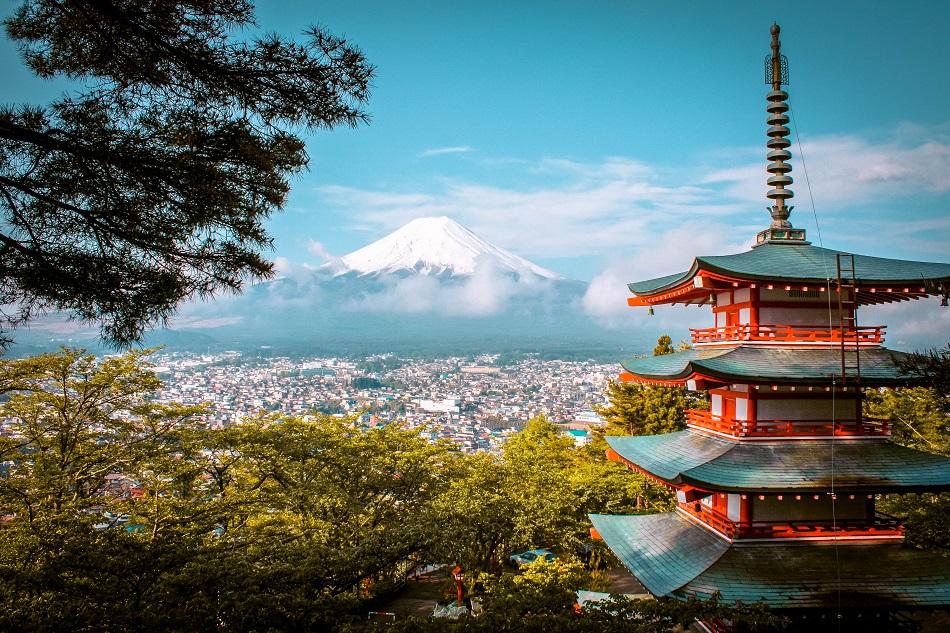
Our three week Japan itinerary continues with a stop at Kawaguchiko, known to offer an incredible view towards Mt. Fuji. Did you know that Mount Fuji is the tallest mountain in Japan (3,776 meters)? Also, Mt. Fuji is still active and last erupted more than 300 years ago.
Fuji is one of the iconic sights in Japan. This place is so unique and beautiful that the sunset at Mt. Fuji has its own name – Goraiko. You’ll have an entire day to explore Kawaguchiko and enjoy some of the most incredible views you’ll ever see.
Below are some of the things you can do in Kawaguchiko.
- Admire Mount Fuji – there are many viewpoints from where you can see Mount Fuji but my favorite one is the promenade in front of Kawaguchiko Hotel New Century. Even though I only saw Fuji for ten minutes before it was fully covered by clouds, I feel super-lucky to have had the chance to see this wonder of nature.
- Visit Chureito Pagoda – admire its beautiful architecture and relax at Chureito Pagoda. This pagoda offers one of the best views towards Mt. Fuji.
- Take the Mount Fuji Ropeway – take the scenic Mount Fuji Panoramic Ropeway and admire the lake, the mountains, the city, and Mount Fuji from above.
- Rent some bicycles or a paddleboat – rent some bicycles and explore Kawaguchiko or rent a paddleboat and paddle around the lake while admiring the reflection of Mt. Fuji into the water. This is the best exercise you’ll ever have!
- Try the world’s steepest roller-coaster – apart from the awesome views, Kawaguchiko is also home to the world’s steepest roller-coaster. Book your tickets to Fuji-Q Highland Theme Park for a few hours of fun and adrenaline.
Out of all the places I’ve seen in Japan, Kawaguchiko will always have a special place in my heart. Make sure to wake up early and enjoy all this place has to offer. Btw, the sunrise over the lake is simply stunning.
It’s time to continue our journey north and our next stop is no other than Japan’s capital city – Tokyo! I know you’ve been waiting for a long time to explore this city and I’am sure that you’ll love it as much as I did.
To get to Tokyo from Kawaguchiko, you’ll have to take the Fujikyuko Line from Kawaguchiko to Otsuki (this ride is not covered by the JR Pass). From Otsuki change trains and head to Tokyo (this part of the trip is covered by the JR Pass). The entire ride will take around 5 hours which means that you’ll arrive in Tokyo late in the evening.
Where to stay in Kawaguchiko
- Luxury – Fufu Hotel – excellent location, excellent view of Mt. Fuji, modern & luxurious rooms, breakfast & dinner included, excellent staff and amenities
- Mid Budget – Lakeland Hotel – good location, clean & spacious rooms, breakfast & dinner included
- Budget – Togawaso – good location, beautiful view toward Fuji, Japanese-style rooms, friendly staff
Day 13-16 in Tokyo – 3 days, 4 nights

Our 3-week Japan trip takes us to Tokyo! Welcome to the city that never sleeps! For me, Tokyo is orderly chaotic. There’s a lot of traffic & many people roaming around the city but somehow everything is where it’s supposed to be. The public transport works on point, you can get anywhere around the city fairly easy, and everything works like a clockwork.
You’ll have 3 full days to explore Tokyo which is enough to visit the most important tourist attractions in the city and feel the city’s vibe. Are you ready to explore one of the most fascinating cities in the world?
Good to know: I HIGHLY recommend getting a Tokyo subway pass for 3 days. With this pass, you’ll have free access on the subway and you’ll save lots of money.
I’ll list below some of the places you can’t miss while in Tokyo.
- Explore the city while wearing a kimono – one of the best experiences you can have in Tokyo is to rent a kimono.
- Visit Gotokuji Temple – this temple is considered to be the birthplace of maneki-neko, the cute white cat used as a talisman around Asia. Visiting Gotokuji Temple is a true delight since you won’t find too many tourists here. Admire the temple and walk between the thousands of maneki-neko cats.
- Be a part of the chaos at Shibuya Crossing – this is the busiest pedestrian crossing in the world and a must-see attraction in Tokyo. Take your time to discover the nearby shopping malls, restaurants and fashion stores.
- Have fun at Tokyo Disneysea – this is one of the best amusement parks in the world! Save one day to have a thrilling and fun experience at Tokyo Disneysea!
- Explore Harajuku – this cool and colorful neighborhood in Tokyo is perfect for a relaxing walk. If you’re lucky, you might even see a few Harajuku girls. While in Harajuku, try the famous crepes, eat some rainbow cotton-candy and shop four souvenirs.
- Admire the views from Tokyo Metropolitan Government Building – there are many places in Tokyo from where you can admire the city but the best one is the Metropolitan Government Building. Moreover, the entrance is free! I recommend getting there at sunset to see the city lighting up.
- Spend the evening at Kabukicho – this is the biggest red-light district in the world! Take a walk on the streets of Kabukicho and you’ll find thousands of neon lights, weird restaurants (you have to try the famous Robot Restaurant), and arcade game rooms.
- Visit the Pokemon Center Mega Tokyo – are you a Pokemon fan? If the answer is yes, then this place is for you! At the Pokemon Center Mega Tokyo you’ll find lots of stuffed Pokemons, accessories, and all kinds of Pokemon merchandise.
- Admire the Senso-ji Temple – this is probably the most visited and the busiest temple in Tokyo. However, it’s architecture is simply stunning. Visiting Senso-ji Temple is a great way to learn more about the Japanese culture.
- Visit Tsukiji Fish Market – visiting Tsukiji Market in Tokyo is not an ordinary experience. This is the largest wholesale fish and seafood market in the world! I recommend going to the tuna auction which starts at 5.20 am. Keep in mind that access is restricted to only 120 visitors so be there as early as possible.
- Step into another world at Tokyo TeamLab Borderless – have you ever seen those photos of people in colorful rooms with never-ending lanterns or balloons? They’re taken at TeamLab Borderless in Tokyo. The artworks here are simply incredible.
- Admire the views from Tokyo Tower – another great place from where you can admire the city is the Tokyo Tower. Head to the top of it and enjoy an incredible view!
- Visit Tokyo Imperial Palace – the imperial palace was destroyed during World War Two but it was rebuilt in the same style. You can admire the Palace from the outside since the inner grounds are usually not open to the public.
I’m sure you’re going to have three full days in Tokyo. This city is very different from everything I’ve seen and its charm is hard to pass unnoticed.
Our next and last destinations are Nagano and Matsumoto. We’re gonna spend 3 nights in Nagano and we’re going to visit Matsumoto as a day trip.
To get from Tokyo to Nagano, take the Hokuriku Shinkansen from Tokyo to Nagano. This ride is covered by the JR Pass.
Where to stay in Tokyo
- Budget – Emblem Hostel – good location, gym, clean rooms, access to train/ subway
- Mid Budget – Hotel Rex – excellent location, included breakfast, modern & spacious rooms, awesome amenities
- Luxury – Ascot Tokyo – excellent location, beautiful pool, spacious & luxurious rooms, excellent staff, great value for money
Day 17-19 in Nagano and Matsumoto – 2 days, 2 nights

Situated right near the famous Jigokudani Monkey Park, Nagano is well known for its skiing slopes, beautiful shrines, and cuisine. We’re going to spend 2 nights here, exploring Nagano and the surrounding areas.
On our last day, we’ll take a day trip to Matsumoto which is our last stop on our 21 day Japan itinerary. Before that, let’s see which are the top things to do in Nagano.
- Check out the snow monkeys – the reason why many tourists come to Nagano is to see the beautiful snow monkeys living in Jigokudani. More than two hundred monkeys live here. When the weather gets cold, they head to the local hot springs for a dip in the warm water. How cool is that?
- Visit Zenkoji Temple – built in the 7th century, this temple is one of the most important pilgrimage sites in Japan. You can admire the temple’s beautiful architecture and buy some talismans from the nearby shops.
- Try the local cuisine – you can’t leave Nagano without trying oyaki. Oyaki are steamed Japanese dumplings with a wide range of fillings (eggplant, pumpkin, mushrooms).
- Admire the Togakushi Shrine – there are five shrines in total and the surrounding nature is stunning. To get to Togakushi Shrine you’ll have to take the Alpico Bus Company from Nagano Station. Enjoy!
- Enjoy the winter sports – if you’re visiting during winter, you’re in luck. Nagano is home to some of the most famous ski resorts in Japan. If you’re not into skiing, you can also go hiking.
After exploring Nagano for one and a half days, it’s time to take a day trip to Matsumoto. The train between these two cities is covered by the JR Pass and the ride takes only 50 minutes.
Where to stay in Nagano
- Budget – Chisun Grand Nagano – good location, good WiFi, spacious rooms, great amenities
- Mid Budget – Hotel Metropolitan Nagano – excellent location, clean & spatious rooms, modern feel, friendly staff
- Luxury – Jizokan Matsuya Ryokan – traditional Japanese accommodation, very clean and spacious, friendly staff, great restaurant
Matsumoto is a beautiful city and to help you get around, I’ve listed the top tourist attractions below.

- Visit Matsumoto Castle – also known as the “Crow Castle” due to its black exterior, the Matsumoto Castle is one of the most beautiful and few remaining original castles in Japan (most of them have been reconstructed).
- Visit Daio Wasabi Farm – you’ll have the chance to see how wasabi is produced at the biggest wasabi farm in Japan. Before leaving, make sure to stop by the shop where you can taste wasabi ice-cream!
Day 19-21 back in Tokyo
Matsumomo was our last stop on our itinerary. Now it’s time to head back to Tokyo for the remaining two nights. You can either choose to relax or you can spend the remaining day exploring more of Tokyo or taking a day trip outside the city.
Below are some awesome day trips from Tokyo.
- Kamikochi day trip from Tokyo – for more details, click here.
- Gunma day trip from Tokyo – for more details, click here.
- Nikko day trip from Tokyo – for more details, click here.
5. Are 3 weeks enough to visit Japan?
Yes! 3 weeks in Japan are enough to explore both the major tourist attractions and some hidden gems too. You’ll have enough time to taste the local cuisine, visit a few temples, have some fun, and explore some museums.
I really hope that you’ve found this itinerary for 3 weeks in Japan useful. I tried to include as many tips & tricks as possible but if you have any questions, don’t hesitate to ask me in the comments section down below.
May the travel bug bite you!
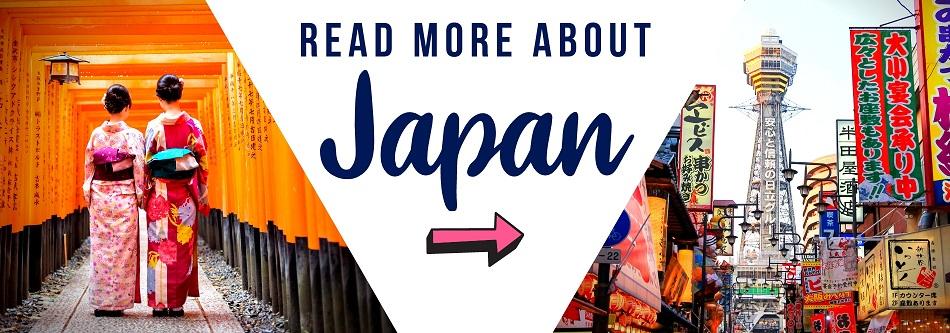
Thank you for posting this. Very specific. Thanks for doing all the math. Greatly appreciated. Loved the detail!
woow ill be using this exact itenarary when i travel to japan